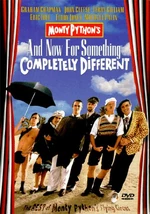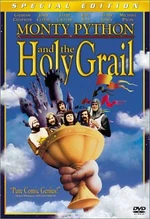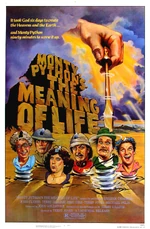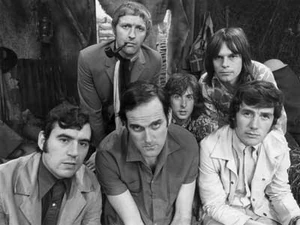
The Python team
Back row: Graham Chapman, Eric Idle, Terry Gilliam.
Front row: Terry Jones, John Cleese, Michael Palin
Monty Python, or The Pythons, is the collective name of the creators of Monty Python's Flying Circus, a British television comedy sketch show that first aired on the BBC on 5 October 1969. A total of 45 episodes were made over four series. However, the Python phenomenon developed from the original television series into something much greater, in scope and impact: it spawned touring stage shows, four films, numerous albums, several books and a spin-off stage musical—as well as launching the members on to individual stardom.
The television series, broadcast by the BBC from 1969 to 1974, was conceived, written and performed by Graham Chapman, John Cleese, Terry Gilliam, Eric Idle, Terry Jones, and Michael Palin. Loosely structured as a sketch show but with a highly innovative stream-of-consciousness approach (aided by Terry Gilliam's animations), it pushed the boundaries of what was then considered acceptable, both in terms of style and in content.
The group's influence on comedy has often been compared to The Beatles' influence on music, [1] [2] a self-contained comedy team responsible for both writing and performing their work and changing the way performers entertained audiences. The Pythons' creative control allowed them to experiment with form and content, discarding the established rules of television comedy and breaking new ground for those who came after (George Harrison, who became friends with several members of the cast, said that he regarded Monty Python as 'continuing the spirit' of The Beatles). Their influence on British comedy of all kinds has been apparent for many years, while in America it has coloured the work of many cult performers from the early editions of Saturday Night Live through to more recent absurdist trends in television comedy.
There are differing accounts of the origins of the Python name although the members agree that its only 'significance' was that they thought it sounded funny. In the 1998 documentary Live At Aspen the group implied that 'Monty' was selected as a gently-mocking tribute to Field Marshal Lord Montgomery, a legendary British general of World War II; requiring a "slippery-sounding" surname, they settled on 'Python'. On other occasions Idle has claimed that the name 'Monty' was that of a popular and rotund fellow who drank in his local pub; people would often walk in and ask the barman, "Has Monty been in yet?", forcing the name to become stuck in his mind. These explanations aside, some believe that 'Monty Bodkin', the name of a character in several books by humourist P. G. Wodehouse, served on some level as an inspiration.
In a 2005 poll to find The Comedian's Comedian, three of the six members were voted among the top 50 greatest comedians ever, by fellow comedians and comedy insiders. Palin was at number 30, Idle was voted 21st and Cleese was at two, just beaten to the top by Peter Cook.
Before Monty Python[]
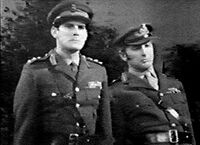
Cleese and Chapman in
At Last the 1948 Show.
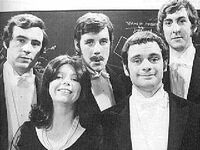
Jones, Palin, Idle (back row) with Denise Coffey and David Jason
in Do Not Adjust Your Set.
Palin and Jones first met at Oxford University, while Cleese and Chapman met at the University of Cambridge. Idle was also at Cambridge, but started a year after Cleese and Chapman. Cleese met Gilliam in New York while on tour with the Cambridge University Footlights revue Cambridge Circus (originally entitled A Clump of Plinths).
Chapman, Cleese and Idle were all members of the Footlights, which at that time also included the future Goodies—Tim Brooke-Taylor, Bill Oddie and Graeme Garden—as well as Jonathan Lynn (co-writer of Yes Minister and Yes, Prime Minister). During the time of Idle's presidency of the club, feminist writer Germaine Greer and broadcaster Clive James were also members. Recordings of these so-called "Smokers" at Pembroke College include sketches and performances by Idle and Cleese. They are currently kept in the archives of the Pembroke Players, along with tapes of Idle's performances in some of the college drama society's theatrical productions.
Variously, the Python members appeared in or wrote, or both, for the following shows before being united for Monty Python's Flying Circus. In particular, The Frost Report is credited as first uniting the British Pythons and providing an environment in which they could develop their particular styles:
- I'm Sorry, I'll Read That Again (radio) (1964–1973) [Cleese: cast member & writer
— Idle and Chapman: writers] - The Frost Report (1966–1967) [Cleese: cast member & writer
— Idle: writer of Frost's monologues — Chapman, Palin & Jones: writers] - At Last the 1948 Show (1967) [Chapman & Cleese: writers & cast members — Idle: writer]
- Twice a Fortnight (1967) [Palin & Jones: cast members & writers]
- Do Not Adjust Your Set (1967–1969) [Palin, Jones & Idle: cast members & writers
— Gilliam: animation — Bonzo Dog Band: musical interludes] - We Have Ways of Making You Laugh (1968) [Idle: cast member & writer — Gilliam: animation]
- How to Irritate People (1968) [Cleese & Chapman: cast members & writers — Palin: cast member]
- The Complete and Utter History of Britain (1969) [Palin & Jones: cast members & writers]
- Doctor in the House (1969) [Cleese & Chapman: writers]
Several of these also featured other important British comedy writers or performers, or both, including Ronnie Corbett, Ronnie Barker, Tim Brooke-Taylor, Graeme Garden, Bill Oddie, Marty Feldman, Jonathan Lynn, David Jason and David Frost.
Following the success of Do Not Adjust Your Set (originally intended to be a children's programme) with the adult demographic, ITV offered Palin, Jones, Idle and Gilliam their own series together. At the same time Cleese and Chapman were offered a show by the BBC, having been impressed by their work on The Frost Report and At Last The 1948 Show. Cleese was reluctant to do a two-man show for various reasons, including Chapman's supposedly difficult personality. Cleese had fond memories of working with Palin and invited him to join the team. With the ITV series still in pre-production Palin agreed and suggested the involvement of his writing partner Jones and colleague Idle—who in turn suggested that Gilliam could provide animations for the projected series. Much has been made of the fact that the Monty Python troupe is the result of Cleese's desire to work with Palin and the chance circumstances that brought the other four members into the fold.[3]
Flying Circus and the Python style[]

Terry Gilliam's Beware of the Elephants animation
The Pythons had a very definite idea about what they wanted to do with the series. They were all great admirers of the work of Peter Cook, Alan Bennett, Jonathan Miller and Dudley Moore on Beyond the Fringe, and had worked on Frost, which was similar in style. They also enjoyed Cook and Moore's sketch show Not Only... But Also. However, one problem the Pythons perceived with these programmes was that though the body of the sketch would be strong, the writers would often struggle to then find a punchline funny enough to end on, and this would detract from the overall quality of the sketch. They decided that they would simply not bother to 'cap' their sketches in the traditional manner, and early episodes of the Flying Circus series make great play of this abandonment of the punchline (one scene has Cleese turn to Idle, as the sketch descends into chaos, and remark that "This is the silliest sketch I've ever been in" - they all resolve not to carry on and simply walk off the set). However, as they began assembling material for the show, the Pythons watched one of their collective heroes, Spike Milligan, recording his new series Q5 (1969). Not only was the programme more irreverent and anarchic than any previous television comedy, Milligan would often "give up" on sketches halfway through and wander off set (often muttering "did I write this?"). It was clear that their new series would now seem somewhat less original, and Jones in particular became determined the Pythons should innovate further.
After much debate, Jones remembered an animation Gilliam had created for Do Not Adjust Your Set called "Beware of the Elephants", which had intrigued him with its stream-of-consciousness style. Jones felt it would be a good concept to apply to the series: allowing sketches to blend into one another. Palin had been equally fascinated by another of Gilliam's efforts, entitled "Christmas Cards", and agreed that it represented "a way of doing things differently." Since Cleese, Chapman and Idle were less concerned with the overall flow of the programme, it was Jones, Palin and Gilliam who became largely responsible for the presentation style of the Flying Circus series, in which disparate sketches are linked to give each episode the appearance of a single stream-of-consciousness (often using a Gilliam animation to move from the closing image of one sketch to the opening scene of another).
Each day of writing started at 9am and finished at 5pm. Typically, Cleese and Chapman worked as one pair of writers isolated from the others, as did Jones and Palin, while Idle wrote alone. After a few days of working in this configuration, they would all join together with Gilliam, critique their scripts and exchange ideas. Their approach to writing was democratic. If the majority found the idea to be humourous, it would be included in the show. The casting of roles for the sketches was a similarly unselfish process, since each member viewed himself primarily as a writer, rather than an actor desperate for screen time. When the themes for sketches were finally chosen, Gilliam was free to decide how to bridge them with animations, armed with his camera, scissors, and airbrush.
While the show was a collaborative process, different factions within Python were clearly responsible for different elements of the team's humour. In general, the work of the Oxford-educated members was more visual, and more fanciful conceptually (e.g. the arrival of the Spanish Inquisition in a suburban front room), while the Cambridge graduates' sketches tended to be more verbal and more aggressive (for example, Cleese and Chapman's many "confrontation" sketches, where one character ends up intimidating or hurling abuse at another, or Idle's characters with bizarre verbal quirks, such as The Man Who Speaks In Anagrams). Asked about this, Cleese has confirmed that "most of the sketches with heavy abuse were Graham's and mine, anything that started with a slow pan across countryside and impressive music was Mike and Terry's, and anything that got utterly involved with words and disappeared up any personal orifice was Eric's."[4] Gilliam's animations, meanwhile, ranged from the whimsical to the savage (the cartoon format allowing him to create some astonishingly violent scenes without fear of censorship).
Several names for the show were bandied about before the title Monty Python's Flying Circus was settled upon. Some of the more memorable were Owl Stretching Time, The Toad Elevating Moment, Vaseline Review and Bun, Wackett, Buzzard, Stubble and Boot. "Flying Circus" stuck when the BBC explained to the group that it had already printed that name in its schedules and was not prepared to amend it, leaving the Pythons no choice in the matter. Many variations then came and went. Gwen Dibley's Flying Circus was named after a woman Palin had read about in the newspaper, thinking it would be amusing if she were to discover she had her own TV show. Barry Took's Flying Circus (also Baron Von Took's Flying Circus) was an affectionate tribute to the man who had brought them together. Arthur Megapode's Flying Circus was suggested, then discarded. Cleese then added "Python", liking the image of a slippery, sly individual that it conjured up. The specific origin of "Monty" is somewhat confused (see above).

Graham Chapman as the Colonel
Flying Circus pioneered some innovative formal techniques, such as the cold open, in which an episode began without the traditional opening titles or announcements.[5] An example of this is the "It's" man: Palin in Robinson Crusoe garb, making a tortuous journey across various terrains, before finally approaching the camera to state, "It's...", only to be then cut off by the title sequence and the theme song. On several occasions the cold open would last until mid show, after which the regular opening titles would run. Occasionally the Pythons would attempt to trick viewers by rolling the closing credits halfway through the show, usually continuing the joke by fading to the familiar "globe logo" used for BBC continuity, over which Idle would parody the clipped tones of a BBC announcer. On one occasion the credits ran directly after the opening titles. They also experimented with ending segments by cutting abruptly to another scene or animation, walking offstage, addressing the camera (breaking the fourth wall), or introducing a totally unrelated event or character. A classic example of this approach was the use of Chapman's "Brigadier" character, who walked into several sketches and ordered them to be stopped because things were becoming "far too silly." Another favourite way of ending sketches was to drop a cartoonish "16-ton weight" prop on one of the characters when the sketch seemed to be losing momentum, before cutting to the next scene (a knight, who would wander on-set and hit characters over the head with a rubber chicken, served a similar purpose).
The Monty Python theme music is "Liberty Bell" march composed by John Philip Sousa. It was not the Pythons' first choice, but the available recording from the BBC archives was in the public domain and therefore free.[5]
- Monty Python - Flying Circus theme (file info) — play in browser (beta)
- The theme music from Monty Python's Flying Circus featuring the "It's..."
- Problems listening to the file? See media help.
The use of Gilliam's surreal, collage stop motion animations was another innovative intertextual element of the Python style. Many of the images Gilliam used were lifted from famous works of art, and from Victorian illustrations and engravings. The giant foot which crushes the show's title at the end of the opening credits is in fact the foot of Cupid, cut from a reproduction of the Renaissance masterpiece Venus, Cupid, Folly, and Time by Bronzino. This foot, and Gilliam's style in general, have come to be considered the visual trademarks of the series.
The Pythons built on and extended the great British tradition of cross-dressing comedy. Rather than dressing a man as a woman purely for comic effect, the (entirely male) Python team would write humourous parts for women, then don frocks and makeup and play the roles themselves. Thus a scene requiring a housewife would feature one of the male Pythons wearing a housecoat and apron, speaking in falsetto. While this accentuated the humour, it was not, in itself, the joke (had a woman played the role, the lines would have had the same comic effect). Generally speaking, female roles were only played by a real woman (usually Carol Cleveland) when the scene specifically required that the character be sexually attractive. In some episodes and the later Monty Python's Life of Brian they took the idea one step further by playing women who impersonated men.
Many of the sketches have become extremely well known outside the hardcore of Python fans, and are still widely quoted to this day. "The Dead Parrot", "The Lumberjack Song", "Spam", "Nudge Nudge", "The Spanish Inquisition", "Upper Class Twit of the Year", "Cheese Shop" and "The Ministry of Silly Walks" are just a few examples.
Life after the Flying Circus[]
The end of Flying Circus[]
Having considered the possibility at the end of the second series, Cleese finally left the Flying Circus at the end of series three. He claimed he felt he was merely repeating himself, that he had nothing fresh to offer the show and that many of his sketches in the third series were merely rewrites of his earlier work. He was also finding Chapman, who was at that point in the full throes of alcoholism, increasingly difficult to work with. According to an interview with Eric Idle "it was on an Air Canada flight on the way to Vancouver, when John (Cleese) turned to all of us and said `I want out.' Why? I don't know. He gets bored more easily than the rest of us. He's a difficult man, not easy to be friendly with. He's so funny because he never wanted to be liked. That gives him a certain fascinating, arrogant freedom."[6]
The rest of the group carried on for one more series (dropping the "Flying Circus" from the show's title, which became just "Monty Python") before calling a halt to the programme in 1974. The name "Monty Python's Flying Circus" appears in the opening animation for Series Four, but in the end credits the show is listed as simply "Monty Python". Despite Cleese's officially leaving the group, he made a cameo appearance in the fourth series. Several episodes credit him as a co-writer since some sketches were recycled from scenes cut from the "Holy Grail" script. While the first three series contained 13 episodes each, the fourth was cut short at only six.
In 1975 the series was first broadcast in America and soon gained a cult following. Ron Deveiller, an executive from PBS television station KERA in Dallas, Texas found Monty Python episodes on a shelf when searching for programming for his station. He watched one episode, then another, and before he was done he had acquired the entire series to put on the air. The series was eventually aired on PBS stations across the country, and by this chance event Python invaded America.
Films[]
And Now For Something Completely Different (1971)[]
This was the Pythons' first feature film, comprised of some of the best sketches from the first series of the Flying Circus, re-shot on an extremely low budget (and often slightly edited) for cinema release. Financed by Playboy's UK executive Victor Lowndes, it was intended as a way of breaking Monty Python in America, and although it was ultimately unsuccessful in this, the film did good business in the UK. The group did not consider the film a success, but it enjoys a cult following today.
Monty Python and the Holy Grail (1975)[]
The group (including Cleese) reformed in 1974 to write and star in their first feature film of new material. The film, Monty Python and the Holy Grail, was based around Arthurian Legend and directed by Jones and Gilliam, the latter also drawing the film's linking animations and opening credits. Along with the rest of the Pythons, Jones and Gilliam performed several roles in the film, but it was Chapman who took the lead as King Arthur. Holy Grail was filmed on a budget of nearly £150,000; this money was raised in part with investments from rock groups such as Pink Floyd and Led Zeppelin - and UK music industry entrepreneur Tony Stratton-Smith (founder/owner of the Charisma Records label for which the Pythons recorded.
The film was shot on location in Scotland, particularly around Doune Castle, Glen Coe, and the privately owned Castle Stalker. Because of the small budget, the film had to make do without horses. This led to one of the film's most memorable gags, as every time the script calls for the knights to be majestically riding their steeds, they are actually play-riding along on foot while their squires behind them bang together coconut half-shells to imitate the sound of horses' hooves (a common radio sound effect now shown on screen for comic effect - though this gag had actually been done previously in the sole surviving episode of the 1956 program A Show Called Fred, produced by Richard Lester and starring Peter Sellers). The chain mail armour worn by the various knights was actually silver-painted wool, whilst the many castles seen throughout the film were either Doune Castle shot from different angles, or cardboard models held up against the horizon (this is used as a small joke, when Arthur and his knights arrive at Camelot, they all remark "Camelot!", then Patsy, Arthur's squire/steed, remarks "It's only a model." to which Arthur replies "Shh!") The filming was apparently unpleasant. The weather was poor and the "chain mail" soaked up rain; the budget only allowed for low-quality hotels which could not provide sufficient hot water for the team to bathe every evening; Gilliam and Jones argued with each other and with the other Pythons; and the extent of Chapman's alcoholism became apparent when he began to suffer from delirium tremens during the filming. The Pythons recall that the filming of Holy Grail is the only time any of them can remember the usually amiable Palin losing his temper. This occurred when Jones and Gilliam insisted on repeatedly re-shooting a scene in which Palin played a character called "the mud eater". The scene was ultimately cut from the movie.
The film proved a success and readers of Total Film magazine voted Monty Python and the Holy Grail the 5th greatest comedy film of all time in 2000.
Monty Python's Life of Brian (1979)[]
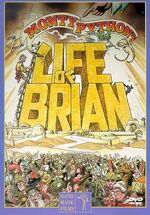
Monty Python's Life of Brian
Following the success of Holy Grail, a reporter asked Idle for the title of the next Python film, despite the fact that the team had not even begun to consider a second movie. Idle flippantly replied "Jesus Christ - Lust for Glory", which became the group's stock answer once they realised that it shut reporters up. However, they soon began to seriously consider a film lampooning the life of Christ in the same way Holy Grail had lampooned King Arthur. Despite being non-believers, they agreed that Jesus was “definitely a good guy” and found nothing to mock in his actual teachings; on the other hand, they shared a distrust of organised religion, and decided to write a satire on credulity and hypocrisy among the followers of a spurious “Messiah”.
The focus therefore shifted to a separate individual born at the same time, in the neighbouring stable, who is subsequently mistaken for the messiah. When Jesus does appear in the film (as he does on two occasions, first in the stable, and then later speaking the Beatitudes - Matt 5:1-48), he is played straight (by British actor Kenneth Colley) - the comedy begins when members of the crowd mishear his statement “Blessed are the Peacemakers” (“I think he said, 'blessed are the cheesemakers'”).
The team decided to write the script during a concentrated script-writing session over a two-week period away from the distractions of the UK. They based themselves in the Caribbean for the writing sessions. After the irritations of Holy Grail's unpleasant locations, they elected to shoot this film in Tunisia. In contrast to Holy Grail, many of the Pythons remember this as their most enjoyable experience working together as a group. Impresario Bernard Delfont became nervous upon reading the script, and abruptly withdrew funding (that he had previously agreed to provide) shortly before filming was due to commence. The project was saved by George Harrison, who immediately set up Handmade Films to finance Brian - budgeted at that time at £5 million. He later quipped that he did so because having read the script he simply wanted to see the film. The Pythons have joked that it is the most anyone has ever paid for a cinema ticket.
The experiment with co-direction on Holy Grail proved to be a one-off, as it led to creative friction. Instead, Jones was left to direct by himself. Though Cleese had originally wanted to play Brian, the rest of the group favoured Chapman, having been impressed by the “noble” quality he brought to his portrayal of King Arthur (they were also conscious that Cleese's performance as Reg had been the highlight of the read-throughs, and he would not have been able to play both parts). Though Chapman only plays Brian and Biggus Dickus, the rest of the cast between them play over 40 characters. Brian also featured brief cameos from George Harrison and Spike Milligan, who just happened to be on holiday in Tunisia at the time; Keith Moon was also set to make a cameo appearance but died before he could film his part.
Upon its release, Christian groups organised protests against the film, based on its perceived blasphemy, particularly in the final scene, a comical song sung by the victims of a mass crucifixion (Idle's "Always Look on the Bright Side of Life"). On its initial release in the UK, the film was banned by several town councils (some of which actually had no cinemas within their boundaries). The film was also banned for eight years in the Republic of Ireland and for a year in Norway (it was marketed in Sweden as 'the movie that is so funny, it was banned in Norway!'). The film was not released in Italy until 1990, eleven years after it was made. The film was not shown in Jersey until 2001, and even then, Bailiff of Jersey Frank Ereaut's government wanted it to be watched only by adults, even though the BBFC had rated it suitable for anyone aged 14 or over.
Mary Whitehouse and other campaigners picketed and distributed leaflets at cinemas showing the film, ironically providing free publicity. Shortly after the film's release, Cleese and Palin appeared in a debate on the BBC2 discussion programme Friday Night, Saturday Morning, in which Malcolm Muggeridge and Mervyn Stockwood, the Bishop of Southwark, put the case against the film. Cleese has frequently said that he enjoyed the debate, since he felt that the film was 'completely intellectually defensible'. Appearing on the Dick Cavett show during the controversy, Cleese said "Either these people are stupid, which they obviously are not, or they have become so enraged that they're incapable of thinking, because they have in fact made me rich." Palin, however, was visibly angry. This discussion (and the earnest reverence for Python among comedy fans) was famously parodied by the Not the Nine O'Clock News, in a sketch featuring a furious debate about The General Synod's Life of Christ, a Biblical film accused of being “a lampoon of the Comic Messiah himself - Our Lord, John Cleese.”
For their part, the Pythons have always maintained (most recently on the DVD commentary) that the film is Christian heresy rather than blasphemous, since it mocks the practices of organised religion rather than the God being worshipped.
Monty Python's The Meaning of Life (1983)[]
Python's final film returned to something closer to the style of Flying Circus. A series of sketches loosely followed the ages of man from conception to death. Directed again by Jones, The Meaning of Life is embellished with some of Python's most bizarre and disturbing moments, as well as various elaborate musical numbers. The film is by far their darkest work, containing a great deal of spectacular violence and black humour: at the time of its release, the Pythons confessed their aim was to offend "absolutely everyone". A short film by Gilliam - The Crimson Permanent Assurance - originally planned as a sketch within the film, eventually grew so ambitious that it was cut from the movie and used as a supporting feature in its own right (on video and DVD, and also in television screenings, this section is tagged onto the start of the film as a prologue).
Though a commercial and critical success, The Meaning of Life is generally not regarded as being of the same quality as its predecessors. Many feel that it lacks the structure of Holy Grail and Life of Brian. Idle claims it was just "one re-write away from being perfect". The Pythons had originally wanted to do one final re-write introducing one lead character (along the lines of Arthur or Brian) who could be followed through the ages of man. However, Cleese refused as he had grown tired of the already protracted writing process for the film.
Crucially, this was the last project that all six Pythons would collaborate on, except for the 1989 compilation Parrot Sketch Not Included where we see the Python cast sitting in a closet for 4 seconds - which would also be the last time Chapman was filmed on screen with the rest of the Pythons.
Python involvement in the Secret Policeman's Ball benefit shows[]
Various members of Monty Python have contributed their services to multiple charitable endeavors and causes over the years - sometimes as an ensemble - at other times as individual members. The cause that has been the most frequent and consistent beneficiary of Monty Python's generosity has been the human rights work of Amnesty International. Between 1976 and 1981, the troupe and/or its members appeared in four major fund-raisers for Amnesty - known collectively as the Secret Policeman's Ball shows - which were turned into multiple films, TV shows, videos, record albums and books. These benefit shows and their many spin-offs raised considerable sums of money for Amnesty, raised public and media awareness of the human rights cause and influenced many other members of the entertainment community (especially rock musicians) to become involved in political and social issues. Among the many musicians who have publicly attributed their activism - and the organization of their own benefit events to the inspiration of the work in this field of Monty Python are Bono, Bob Geldof, Pete Townshend and Sting. The shows are also credited by Amnesty with helping the organization develop public awareness in the USA where one of the spin-off films was a major success.
Two of the six Pythons - Cleese and Jones - had an involvement (as performer, writer and/or director) in all four Amnesty benefit shows. Palin was involved in three, Chapman in two and Gilliam in one. Eric Idle did not participate in any of the Amnesty shows. Notwithstanding Idle's lack of participation - the other five members (together with two "Associate Pythons" - Carol Cleveland and Neil Innes - all appeared together in the first Secret Policeman's Ball benefit - the 1976 A Poke In The Eye (With A Sharp Stick) performing several Python skits and in this first show, they were collectively billed as Monty Python. (Peter Cook deputized for the errant Eric Idle in one major skit The Courtroom). In the next three shows, the participating Python members performed many Python skits - but were billed under their individual names rather than under the collective Python banner. After a six-year break, Amnesty resumed producing Secret Policeman's Ball benefit shows in 1987 (sometimes with, and sometimes without variants of the iconic title) and by 2006 had presented a total of twelve such shows. The shows since 1987 have featured newer generations of British comedic performers - including many who have attributed their participation in the show to their desire to emulate the Python's pioneering work for Amnesty. (Cleese and Palin made a brief cameo appearance in the 1989 Amnesty show - but apart from that, the Python members have not appeared in any of the shows after the legendary first four shows.)
Python (Monty) Pictures[]
George Harrison in All You Need Is Cash.
The five surviving members of the main Monty Python team are directors of Python (Monty) Pictures Limited which was incorporated in 1973 and now manages ongoing activities resulting from their previous work together. In the accounts return, the company describes its activities as the 'exploitation of television and cinematographic productions'. In the last financial year for which accounts are available (to March 2004), the company's turnover was £4.9M (source: Creditsafeuk.com).
When Monty Python's Flying Circus was shown in the US by ABC in their "Wide World of Entertainment" slot in 1975, the episodes were re-edited to allow time for commercials, thus losing the continuity and flow intended in the originals. When ABC refused to stop screening the series in this form, the Pythons took them to court. Initially the court ruled that their artistic rights had indeed been violated, but refused to stop the ABC broadcasts as this would cause “financial damage” to ABC. However, on appeal the team gained control over all subsequent U.S. broadcasts of its programmes. The case also led to them gaining the foreign rights to all Python shows from the BBC, once their original contracts ended at the end of 1980 (a unique arrangement at the time).[7]
A driving force behind Python in the late 1970s was George Harrison, who not only funded Life of Brian but guest-starred as Mr Papadopolous (though his voice is dubbed by Palin), and also produced a number of their songs from that period, including "The Lumberjack Song" Single (music). He also made a cameo appearance in Idle and Neil Innes' cult Beatles parody All You Need Is Cash (aka The Rutles), which also featured cameo appearances by three members of America's Saturday Night Live team - produced by Broadway Video, SNL's production company. Harrison even claimed in an interview that "Monty Python helped me get over the trauma of the breakup of the Beatles."[8]Template:Clear
Four of the remaining Pythons (excluding John Cleese) reunited along with Python associate Neil Innes for a Concert for George salute to Harrison on the first anniversary of Harrison's death in 2002.
Going solo[]
Each member pursued other film and television projects after the break-up of the group, but often continued to work with one another. Many of these collaborations were very successful, such as Fawlty Towers (written by and starring Cleese and his then wife Connie Booth), and A Fish Called Wanda (1988) (also written by Cleese, and in which he starred along with Palin). The latter pair also appeared in Time Bandits (1981), a movie written by Gilliam and Palin, and directed by Gilliam. Gilliam also directed and co-wrote Brazil (1985) and The Adventures of Baron Munchausen (1988), which featured Palin and Idle respectively. Gilliam has now become a cult director; he often struggles to find the money for his work because his films tend to go over-budget and fail at the box-office. Palin and Jones wrote the comedic film series Ripping Yarns, starring Palin with an assortment of British actors. Palin's BBC travel series have also proved extremely popular as have Jones' historical documentaries. In terms of numbers of productions, John Cleese has had the most prolific solo career, having appeared in 59 theatrical movies, 22 TV shows or series (including Cheers and Will and Grace), 23 direct-to-video productions, six video games, and a number of commercials.[9] Idle enjoyed critical success with Rutland Weekend Television in the mid-70s and as an actor in Nuns on the Run (1990) with Robbie Coltrane. He also had a UK #3 single with "Always Look on the Bright Side of Life."
Post-Python reunions[]
The Pythons last full work together as an ensemble was for the film Meaning Of Life in 1983. Since then, the Pythons have often been the subject of reunion rumours. The death of Chapman in 1989 (on the eve of their 20th anniversary) seemed to put an end to this speculation.
However, there have been several occasions since 1983 when the surviving five members have gathered together for appearances - albeit not formal reunions.
In 1998 the five remaining members, along with what was purported to be Chapman's ashes, were reunited on stage for the first time in 18 years. The occasion was in the form of an interview (hosted by Robert Klein, with an appearance by Eddie Izzard) in which the team looked back at some of their work and performed a few new skits. One of the show's more memorable moments occurred when what were supposed to be Chapman's ashes were "accidentally" spilled- the person responsible for upsetting the urn was Gilliam – then hurriedly cleaned up with a mini-vacuum cleaner and a broom and dustpan. A significant amount of the ashes were also brushed under the rug.
On 9 October 1999, to commemorate 30 years since the first Flying Circus television broadcast, BBC2 devoted an evening to Python programmes, including a documentary charting the history of the team, interspersed with new sketches by the Monty Python team filmed especially for the event; the program appears, though omitting a few things, on the DVD The Life of Python.
In an interview to publicise the DVD release of The Meaning of Life, Cleese said a further reunion was unlikely. "It is absolutely impossible to get even a majority of us together in a room, and I'm not joking," Cleese said. He said that the problem was one of business rather than one of bad feelings.[10]
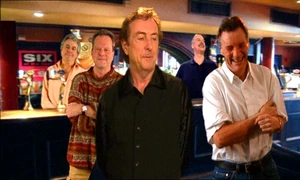
The Pythons on the Meaning of Life DVD, using special effects to have a reunion... but not very seriously.
A sketch appears on the same DVD spoofing the impossibility of a full reunion, bringing the members “together” in a deliberately unconvincing fashion with modern bluescreen/greenscreen techniques.
Idle has responded to queries about a Python reunion by adapting a line used by George Harrison in response to queries about a possible Beatles reunion. When asked in the early 1990s about such a possibility, Harrison responded: "As far as I'm concerned, there won't be a Beatles reunion as long as John Lennon remains dead." Idle's version of this was that he expected to see a proper Python reunion, "just as soon as Graham Chapman comes back from the dead", but then he added a classic Python spin: "we're talking to his agent about terms."
2003's The Pythons Autobiography By The Pythons, compiled from a series of interviews with the surviving members, reveals that a series of disputes in 1990 over a Monty Python and the Holy Grail sequel conceived by Idle may have resulted in the group's permanent fission. Cleese's feeling was that Monty Python's Meaning of Life had been personally difficult and ultimately mediocre, and for this and other reasons did not wish to be involved. Apparently Idle was angry with Cleese for refusing to do the film, which most of the remaining Pythons thought reasonably promising. A still-smarting Idle refused to appear in what he saw as the Cleese-dominated reunion show a few years later (his place was taken by Eddie Izzard).
The members have continued to appear in each other's films. Terry Gilliam has directed Michael Palin, John Cleese, Terry Jones and Eric Idle in various non-Python pictures, Graham Chapman worked with John Cleese and Eric Idle in Yellowbeard and Michael Palin and John Cleese worked together in the acclaimed A Fish Called Wanda and Fierce Creatures. Terry Jones' 1996 adaptation of The Wind in the Willows featured all the surviving Python members, except for Terry Gilliam, who was going to play The River but could not find space in his schedule. The next film reunion will be in Shrek the Third, in which John Cleese and Eric Idle have voice-over roles, though they don't share any scenes together.

The Pythons in 2002 for Concert for George, recreating the famous 'Lumberjack song'
March 2005 saw a full, if non-performing, reunion of the surviving cast members at the premiere of Eric Idle's musical Spamalot, based on Monty Python and the Holy Grail. It opened in Chicago and has since played in New York on Broadway theatre, and is currently entertaining audiences in Toronto, Ontario. In 2005, it was nominated for 14 Tony Awards and won three: Best Musical, Best Direction of a Musical for Mike Nichols and Best Performance by a Featured Actress in a Musical for Sara Ramirez, who played the Lady of the Lake, a character specially added for the musical.
Owing in part to the success of Spamalot, PBS announced on July 13, 2005, that the network would begin to re-air the entire run of Monty Python's Flying Circus, as well as new one-hour specials focusing on each member of the group, called Monty Python's Personal Best.[11] Each episode was written and produced by the individual being honoured, with the five remaining Pythons collaborating on Chapman's programme.
The Pythons[]
Graham Chapman[]
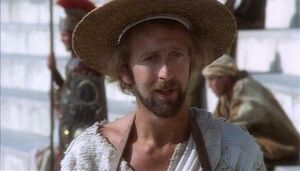
Chapman as Brian Cohen in Life of Brian
Born in Melton Mowbray, Leicestershire, England on 8 January 1941, Chapman was originally a medical student, but changed to theatre when he joined Footlights at Cambridge (he did in fact complete his medical training and was legally entitled to practice as a doctor). Chapman is best remembered for taking the lead roles in The Holy Grail, as King Arthur, and Life of Brian, as Brian Cohen.
These were largely straight roles, but in the Flying Circus, he had tended to specialise in characters closer to his own personality: outwardly calm, authoritative figures barely concealing a manic unpredictability. In many ways, Chapman was the epitome of public-school respectability, a tall, craggy pipe-smoker who enjoyed mountaineering and playing rugby. At the same time, he was proudly gay, highly eccentric (Douglas Adams remembered seeing Chapman in his local pub, casually whacking his penis against the bar to attract the attention of the bar staff) and, by the start of the 1970s, an alcoholic who was beginning to cause problems for the other Pythons with his excessive drinking.
Chapman had been infuriating the others by performing drunk on stage, missing cues and forgetting lines (a habit that had begun during the later television shows), and had particular trouble filming Holy Grail in Scotland, where he got a case of delirium tremens, often called DTs. At the height of his alcoholism, he was reportedly consuming two quarts of gin every day.[12] On accepting his definitive role of Brian, he finally made the decision to stop drinking, and was sober by the time filming began – his performance in the film is arguably the finest of his career.
Besides starring in Monty Python features, Chapman appeared in movies such as The Odd Job (which he also produced) and Yellowbeard (which he directed), also making several appearances on Saturday Night Live. He died of spinal and throat cancer on 4 October 1989. He is now lovingly referred to by the surviving Pythons as "the dead one." At Chapman's memorial service, Cleese delivered the irreverent speech he felt his co-writer would have wanted: having been the first person to say “shit” on British television, Cleese announced, Chapman would never have forgiven him had he missed the opportunity to become “the first person ever at a British memorial service to say 'fuck'.” He was survived by partner of 24 years, David Sherlock and adopted son, John Tomiczak.
John Cleese[]
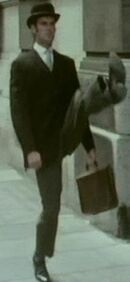
Cleese performing his silly walk
Born on 27 October 1939 in Weston-super-Mare, North Somerset, England, Cleese's family surname had originally been Cheese. His father, however, had it changed to Cleese when he joined the army during World War I. Cleese attended Clifton College, Bristol where he developed a taste for performing by appearing in house plays, then moved on to Cambridge, where he met his future Python writing partner, Graham Chapman.
Along with Gilliam's animations, Cleese's work with Chapman provided Python with its darkest and angriest moments, and many of his characters display the seething suppressed rage that later characterised his portrayal of Basil Fawlty. Many critics naturally make a connection with Cleese's own self-confessed neuroses (he has spoken openly about receiving psychoanalysis).
Unlike Palin and Jones, Cleese and Chapman actually wrote together, in the same room; Cleese claims that their writing partnership involved him sitting with pen and paper, doing most of the work, while Chapman sat back, not speaking for long periods, then suddenly coming out with an idea that often elevated the sketch to a different level. A classic example of this is the "Dead Parrot" sketch, envisaged by Cleese as a satire on poor customer service, which was originally to have involved a broken toaster, and later a broken car (this version was actually performed and broadcast, on the pre-Python special How To Irritate People). It was Chapman's suggestion to change the faulty item into a dead parrot, giving the sketch a surreal air which made it far more memorable.
Their humour often involved ordinary people in ordinary situations behaving absurdly for no obvious reason. Like Chapman, Cleese's poker face, clipped middle-class accent and imposing height allowed him to appear convincing as a variety of authority figures - which he would then proceed to undermine. Many of his characters have a kind of incipient madness, but remain utterly straight-faced and impassive while behaving in a ludicrous fashion. Most famously, in the "Ministry of Silly Walks" sketch (actually written by Palin and Jones), Cleese exploits his extraordinary stature as the crane-legged civil servant performing a grotesquely elaborate walk to his office.
Chapman and Cleese also specialised in sketches where two characters would conduct highly articulate arguments over completely arbitrary subjects, such as in the "cheese shop", the "dead parrot" sketch and, perhaps most notably, the "argument sketch”, where Cleese plays a stone-faced bureaucrat employed to sit behind a desk and engage people in pointless, infuriatingly trivial bickering. All of these roles were opposite Palin (who Cleese often claims is his favourite Python to work with) – the comic contrast between the towering Cleese's crazed aggression and diminutive Palin's shuffling inoffensiveness is a common feature in the series. Occasionally, the typical Cleese-Palin dynamic is reversed, as in "Fish Licence" wherein Palin plays the bureaucrat with whom Cleese is trying to work (though it is still Cleese who plays the "loony" half of the duo).
Cleese has recently had a species of lemur named after him, Avahi cleesei (or "Cleese's Woolly Lemur").[13] This was in recognition of his promotion of conservation issues after the release of his film Fierce Creatures, which featured such an animal, and Operation Lemur with John Cleese, which highlighted their plight on the island of Madagascar — their natural habitat.
In 1999, Cleese played Q's assistant ("R") in the James Bond movie The World Is Not Enough. He then took on the role of Q in the 2002 James Bond film Die Another Day. He also has done work for Shrek 2, and appeared in the first two Harry Potter movies, Rat Race, and several Saturday Night Live episodes. He will be in Shrek the Third with fellow Python member, Eric Idle.
Terry Gilliam[]
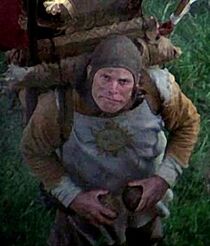
Gilliam as King Arthur's trusty servant/steed Patsy in Holy Grail
Gilliam, born in Minneapolis, Minnesota, USA, on 22 November 1940, is the only non-British member of the troupe (although now a British citizen). He started off as an animator and strip cartoonist for Harvey Kurtzman's Help! magazine, one issue of which featured Cleese. Moving from the US to England, he animated features for Do Not Adjust Your Set and then joined Monty Python's Flying Circus when it was created.
He was the artist-animator of the distinctive, surreal cartoons which linked the show's sketches together, and defined the group's visual language in other mediums (such as LP and book covers, and the title sequences of their films). He mixed his own art, characterised by soft gradients and odd bulbous shapes, with backgrounds and moving cutouts from antique photographs, often from the Victorian era. The style has been mimicked repeatedly throughout the years: in the children's television cartoon Angela Anaconda, a series of television commercials for Guinness, the JibJab cartoons featured on The Tonight Show with Jay Leno, the online comic strip The New Adventures Of Queen Victoria, and the television history series Terry Jones' Medieval Lives. The title sequence for Desperate Housewives and the visits to the land of the living in Grim Fandango are also highly Gilliamesque. The style of animation used for South Park was inspired by Gilliam's paper cut-out cartoons for Monty Python's Flying Circus. Most recently, episodes of the Food Network series Good Eats have also included Gilliam-esque linking segments.
Besides doing the animations for the Flying Circus, he also appeared in several sketches, usually playing parts that no one else wanted to play (generally because they required a lot of make-up or uncomfortable costumes, such as a recurring knight in armour who would end sketches by walking on and hitting one of the other characters over the head with a plucked chicken) and took a number of small roles in the films.
He co-directed Monty Python and The Holy Grail and directed short segments of other Python films (for instance "The Crimson Permanent Assurance", the short film that appears before The Meaning of Life). Gilliam has gone on to become a celebrated and imaginative film director of such notable titles as Brazil, Twelve Monkeys and Fear and Loathing in Las Vegas.
Eric Idle[]
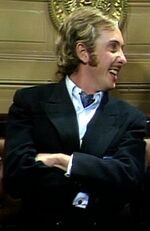
Idle as the annoying man in the Nudge Nudge sketch.
Idle was born on 29 March 1943 in South Shields, Tyne and Wear, England. When Monty Python was first formed, two writing partnerships were already in place: Cleese and Chapman, Jones and Palin. That left Gilliam in his own corner, operating solo due to the nature of his work - and Idle.
Idle was content to be cast as the group loner, preferring to write by himself, at his own pace, although he sometimes found it difficult in having to present material to the others and make it seem funny without the back-up support of a partner. Cleese admitted that this was slightly unfair – when the team voted on which sketches should appear in a show, “he only got one vote” - but says that Idle was an independent person and worked best on his own. Idle himself admitted this was sometimes difficult: “You had to convince five others. And they were not the most un-egotistical of writers, either."
Idle's work in Python is often characterised by an obsession with language and communication: many of his characters have verbal peculiarities, such as the man who speaks in anagrams, the man who says words in the wrong order, and the butcher who alternates between rude and polite every time he speaks. A number of his sketches involve extended monologues (for example the man who won't stop talking about his previous and unpleasant experiences with holidays), and he would frequently spoof the unnatural language and speech patterns of television presenters. Additionally, like Michael Palin, Idle is said to be the master of insincere characters, from the David Frost-esque Timmy Williams, to Stig O'Tracy, who tries to justify the fact that organized crime master Dinsdale Piranha had nailed his head to the floor.
One of the younger members of the team - a year behind Cleese and Chapman at Cambridge, Idle was closest in spirit to the students and teenagers who made up much of Python's fanbase. It should not be surprising that the Python sketches dealing most with contemporary obsessions like pop music, sexual permissiveness and recreational drugs are Idle's work, often characterized by wry double entendre, sexual references, and other "naughty" subject matter - most famously demonstrated in "Nudge Nudge."
A competent guitarist, Idle composed the group's most famous musical numbers, most notably the Life of Brian closing number "Always Look on the Bright Side of Life," which has grown to become a Python signature tune. He was responsible for the Galaxy Song from The Meaning Of Life and (with Cleese) Eric The Half-A-Bee, a whimsical tune that first appeared on Monty Python's Previous Record.
Since Python, Idle starred in his own successful series, Rutland Weekend Television, and from it co-created The Rutles, a Beatles parody, along with Neil Innes. He has had cameo roles in movies ranging from South Park: Bigger, Longer & Uncut to National Lampoon's European Vacation to 102 Dalmatians to television shows such as The Simpsons, MADtv and Saturday Night Live and even starred in the 1996 "point-and-click" computer game Discworld, in which he voiced the game's protagonist Rincewind. He also continues to compose humorous songs, including the theme to the BBC sitcom One Foot In The Grave.
Idle's solo career faltered in the 1990s with the failures of his 1993 film Splitting Heirs (written, produced by and starring Idle) and 1998's Burn Hollywood Burn (in which he starred) - which was awarded five Golden Raspberry "Razzie" Awards including 'Worst Picture of the Year'. He revived his career by returning to the source of his success from the 1970s - and adapting Monty Python material for other media. He is the writer of the Tony award-winning Broadway musical, Spamalot, based on the Holy Grail movie. He also collaborated with John Du Prez on the music for the show. He has written another Monty Python-derived stage musical, Not the Messiah (He's a Very Naughty Boy) that premiered in Montreal in summer 2007. He is also a voice talent in Shrek the Third along with fellow Python member, John Cleese.
Terry Jones[]
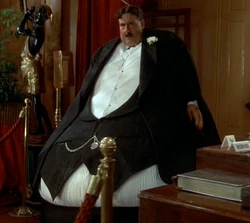
Jones as Mr Creosote in Meaning of Life
Jones was born on 1 February 1942 in Colwyn Bay, North Wales. The mildest member of Python, he has rarely received the same attention as his colleagues, but has been described by other members of the team as the “heart” of the operation. Python biographer George Perry has commented that should you "speak to him on subjects as diverse as fossil fuels, or Rupert Bear, or mercenaries in the Middle Ages or Modern China... in a moment you will find yourself hopelessly out of your depth, floored by his knowledge." Many others agree that Jones is characterised by his irrepressible, good-natured enthusiasm, which is perhaps the reason for his unflagging loyalty to the preservation of the group. However, Jones' passion often led to prolongued arguments with other group members - in particular Cleese - with Jones often unwilling to back down.
One of Jones' early concerns was devising a fresh format for the Python TV shows, and it was largely Jones who developed the stream-of-consciousness style which abandoned punchlines and instead encouraged the fluid movement of one sketch to another - allowing the team's conceptual humour the space to “breathe”. Jones also objected to TV directors’ use of sped-up film, over-emphatic music, and static camera style, and took a keen interest in the direction of the shows. He later committed himself to directing the Python films Monty Python and the Holy Grail, The Life of Brian, and Monty Python's Meaning of Life, and as director, finally gained fuller control of the projects, devising a visual style that allowed the performers 'space'; for instance, in the use of wide shots for long exchanges of dialogue, and more economical use of music. As demonstrated in many of his sketches with Palin, Jones was also interested in making comedy that was visually impressive, feeling that interesting settings augmented, rather than detracted from, the humour. His methods encouraged many future television comedians to break away from conventional studio-bound shooting styles, as demonstrated into the 21st century by shows such as Green Wing, Little Britain and The League of Gentlemen (comedy).
Of Jones' contributions as a performer, his parodic, screechy-voiced depictions of middle-aged women are among the most memorable. His humour, in collaboration with Palin, tends to be conceptual in nature; a typical Palin/Jones sketch draws its humour from the absurdity of the scenario. For example, in the “Summarise Proust Competition”, Jones plays a cheesy game show host giving a series of contestants 15 seconds to condense Marcel Proust's lengthy work A La Recherche Du Temps Perdu; in the "Mouse Organ" sketch, he plays a tuxedoed man using mallets to bash mice who have been trained to squeak at a select pitch, and when “played” in the correct order reproduce the tune "Bells of St. Mary". In both cases, the laughs originate in the madness of the idea itself. Jones was also notable for his gifts as a Chaplinesque physical comedian, perhaps best demonstrated in the "Undressing in Public" sketch.
In 2004, Jones was the presenter and actor for the BBC's miniseries, Terry Jones' Medieval Lives. He has also directed and starred in Erik the Viking, and in 2006 presented a series on BBC2 entitled Barbarians.
Since his major contributions were largely behind the scenes (direction, writing), and he often deferred to the other members of the group as an actor, Jones' importance to Python was often underrated. Recent Python literature has highlighted his lead role in maintaining the group's unity and creative independence. He was diagnosed with bowel cancer in October 2006.
Jones died from dementia on January 21st, 2020
Michael Palin[]
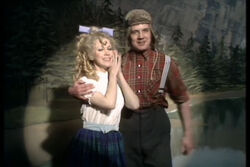
Palin with Connie Booth performing The Lumberjack Song
Born on 5 May 1943 in Sheffield, South Yorkshire, England. The youngest Python by a matter of weeks, Palin is often lovingly referred to as "the nice one." He attended Oxford, where he met his Python writing partner Jones. The two also wrote the series Ripping Yarns together. Palin and Jones originally wrote face-to-face, but soon found it was more productive to write apart and then come together to review what the other had written. Therefore, Jones and Palin's sketches tended to be more focused than that of the other four, taking one bizarre, hilarious situation, sticking to it, and building on it.
These sketches take everyday situations: idle chatter in the sitting room; dining out — and introduce an unexpected rogue element: Cardinals of the Spanish Inquisition; an impossibly overweight man with the equally improbable surname of Creosote. From here, Palin and Jones commence to elaborate upon the newly created environment, carrying it to logical or illogical extremes: having waiter Cleese feed Mr Creosote until he actually explodes, showering the other diners in viscera; or attempting to torture innocent old ladies with cushions and comfy chairs.
In recent years, Palin has starred in a number of documentary travel series for the BBC in which he visits various — usually remote — locales, often along some predetermined route; for example his series Pole to Pole and the BBC-sponsored Around the World in Eighty Days, where he followed the route of the fictional journey of Phileas Fogg in Jules Verne's novel of the same name. He also starred in Gilliam's Brazil and Time Bandits, and hosted Saturday Night Live several times. Largely through his travel shows, Palin has become one of the most popular television personalities in Britain. He was also voted the best-looking member of the Monty Python group by the public.
Associate Pythons[]
Several people have been accorded unofficial "Associate Python" status over the years. Occasionally such people have been referred to as the 7th Python - in a style reminiscent of associates of the Beatles being dubbed "The 5th Beatle." The two collaborators with the most meaningful and plentiful contributions have been Neil Innes and Carol Cleveland. Both were present and presented as Associate Pythons at the official Monty Python 25th anniversary celebrations held in Los Angeles in July 1994.
Neil Innes[]
Neil Innes is the only non-Python besides Douglas Adams to be credited with writing material for the Flying Circus. He appeared in sketches and the Python movies, as well as performing some of his songs in Monty Python Live at the Hollywood Bowl. He was also a regular stand-in for absent Pythons on the rare occasions when they appear to re-create sketches. For example, he took the place of Cleese when he was unable to appear at the memorial concert for George Harrison. Gilliam once noted that if anyone qualified for the title of the "Seventh Python," it would certainly be Innes. He was one of the creative talents in the off-beat Bonzo Dog Band, appreciated for such nutty compositions as "The Intro and the Outro" and "I'm The Urban Spaceman." He would later portray Ron Nasty of the Rutles and write all of the Rutles' compositions for All You Need is Cash. By 2005, an unfortunate falling out had occurred between Eric Idle and Innes over additional Rutles projects, the results being Innes' critically acclaimed Rutles "reunion" album The Rutles: Archaeology and Idle's undistinguished, straight-to-DVD Rutles sequel The Rutles 2: Can't Buy Me Lunch, each undertaken without participation from the other. According to an interview with Idle carried by the Chicago Tribune in May 2005, his attitude as a result of the dispute is that he and Innes go back "too far. And no further." Innes has maintained a diplomatic silence on the dispute.
Carol Cleveland[]
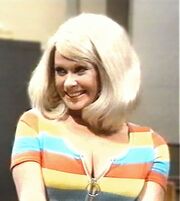
Carol Cleveland as the stereotypical "blonde bombshell" in the Marriage Guidance Counsellor sketch.
Commonly referred to as the "Seventh Python," or the "Python Girl," Carol Cleveland was the most important female performer in the Monty Python ensemble. Originally hired by producer/director John Howard Davies for just the first five episodes of Monty Python's Flying Circus, she went on to appear in approximately two-thirds of the episodes as well as in all of the Python films, and in most of their stage shows as well. Her common portrayal as the stereotypical "blonde bimbo" eventually earned her the sobriquet "Carol Cleavage" by the other Pythons, but she felt that the variety of her roles should not be described in such a pejorative way.
Other contributors[]
Connie Booth[]
John Cleese's ex-wife Connie Booth, who went on to write and star with him in Fawlty Towers, was probably the only other significant female performer. She appeared in, amongst others "The Lumberjack Song" and as the "witch" in Monty Python and the Holy Grail. It has been suggested that she may also have assisted Cleese and Chapman in their writing.
Douglas Adams[]
Douglas Adams was "discovered" by Graham Chapman when a version of the Footlights Revue (a 1974 BBC2 television show featuring some of Adams' early work) was performed live in London's West End. The two formed a brief writing partnership, and Adams earned a writing credit in one episode (episode 45: "Party Political Broadcast on Behalf of the Liberal Party") of Monty Python's Flying Circus for a sketch called "Patient Abuse". In the sketch, a man who had been stabbed by a nurse arrives at his doctor's office bleeding profusely from the stomach, when the doctor makes him fill out numerous senseless forms before he can administer treatment (a joke Adams later incorporated into the Vogons' obsession with paperwork in The Hitchhiker's Guide to the Galaxy). Adams also contributed to a sketch on the album for Monty Python and the Holy Grail. He had two "blink and you miss them" appearances in the fourth series of Monty Python's Flying Circus. At the beginning of Episode 42, "The Light Entertainment War," Adams is in a surgeon's mask (as Dr Emile Koning, according to the on-screen captions), pulling on gloves, while Michael Palin narrates a sketch that introduces one person after another, and never actually gets started. At the beginning of Episode 44, "Mr Neutron," Adams is dressed in a "pepperpot" outfit and loads a missile onto a cart, driven by Terry Jones, who is calling out for scrap metal ("Any old iron..."). The two episodes were first broadcast in November 1974. Adams and Chapman also attempted a few non-Python projects, including Out of the Trees.
Eddie Izzard[]
Stand-up comedian Eddie Izzard, a devoted fan of the group, has occasionally stood in for absent members. When the BBC held a "Python Night" in 1999 to celebrate 30 years of the first broadcast of Flying Circus, the Pythons recorded some new material with Izzard standing in for Idle, who had declined to partake in person. (Idle taped a solo contribution from the US.) Izzard hosted a history of the group entitled The Life of Python (1999) that was part of the Python Night and appeared with them at a festival/tribute in Aspen, Colorado, in 1998 (released on DVD as Live at Aspen).
British Prime Minister (1979-1990) Margaret Thatcher spoofs the Dead Parrot sketch.
'Pythonesque'[]
Monty Python casts a considerable shadow over modern comedy. As such, the term 'pythonesque' has become a byword in surreal humour. However, this is perhaps somewhat misleading, since the humour of Monty Python, whilst certainly nonsensical and surreal, is still strongly characterised by a preoccupation with sociological concepts such as the British social class system. These themes cannot be said to be essential to surrealist comedy as a whole.
Python media[]
Television[]
- Monty Python's Flying Circus (1969–1974)
- The show that started the Python phenomenon. See also List of Monty Python's Flying Circus Episodes.
- Two 45-minute specials made by Westdeutscher Rundfunk for West German television. The first was recorded in German, while the second was in English with German dubbing.
- Monty Python's Personal Best (2006)
- Six one-hour specials, each episode presenting the best of one member's work.
Films[]
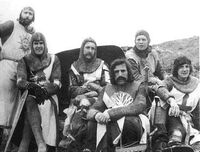
Cast on the set of Monty Python and the Holy Grail. From Left to Right: Graham Chapman, John Cleese, Eric Idle, Terry Jones, Terry Gilliam and Michael Palin.
There were five Monty Python films:
- A collection of re-filmed sketches from the first and second series of Monty Python's Flying Circus.
- King Arthur and his knights embark on a low-budget search for the Holy Grail, encountering humorous obstacles along the way. Some of these turned into standalone sketches.
- Monty Python's Life of Brian (1979)
- Brian is born on the first Christmas, in the stable next to Jesus'. He spends his life being mistaken for a messiah.
- Live performance of skits directed by Ian MacNaughton.
- An examination of the meaning of life in a series of sketches from conception to death and beyond, from the uniquely Python perspective.
Albums[]
- Monty Python's Flying Circus (1970)
- Another Monty Python Record (1971)
- Monty Python's Previous Record (1972)
- The Monty Python Matching Tie and Handkerchief (1973)
- Monty Python Live at Drury Lane (1974)
- The Album of the Soundtrack of the Trailer of the Film of Monty Python and the Holy Grail (1975)
- Monty Python Live at City Center (1976)
- The Monty Python Instant Record Collection (1977)
- Monty Python's Life of Brian (1979)
- Monty Python's Contractual Obligation Album (1980)
- Monty Python's Meaning of Life (1983)
- Monty Python's The Final Rip Off (1988)
- Monty Python Sings (1989)
- The Ultimate Monty Python Rip Off (1994)
- The Instant Monty Python CD Collection (1994)
- Monty Python's Spamalot (Broadway version of Monty Python and the Holy Grail with Tim Curry as King Arthur) (2005)
- The Hastily Cobbled Together Album (2006)
Theatre[]
- Monty Python's Flying Circus — between 1974 and 1980 (Live at the Hollywood Bowl was released in 1982 but was performed in 1980) the Pythons made three sketch based stage shows, comprising mainly of material from the original television series.
The first and only authorised stage version of the sketch show to be performed by non-Pythons is currently touring Great Britain, and is highly successful, with Gilliam calling it, 'better than we could manage at the time'. This is despite its twist — the fact that it is being performed in French. It was originally performed in Paris where it was successful before being a surprise hit at the Edinburgh Fringe Festival. With the strapline, 'Et maintenant pour quelque chose complètement différent!'. It is titled for English audiences with similar facilities to those used for deaf or hearing-impaired.[14] - Monty Python's Spamalot (The musical 'lovingly' ripped off from the motion picture Monty Python and the Holy Grail)
Written by Idle directed by Nichols, with music and lyrics by John Du Prez and Idle, and starring Hank Azaria, Tim Curry, and David Hyde Pierce, Spamalot is a musical adaptation of the film Monty Python and the Holy Grail. It ran in Chicago from December 21, 2004 to January 23, 2005, and began showing on Broadway on March 17, 2005. It won three Tony awards. - Not the Messiah (He's a Very Naughty Boy)
The Toronto Symphony Orchestra have commissioned Eric Idle and John Du Prez to write the music and lyrics of an oratorio based on Monty Python's Life of Brian. Entitled Not the Messiah, it will have its world premiere as part of Luminato, a "festival of arts and creativity" taking place June 1–10, 2007 in Toronto. Not the Messiah will be conducted by Peter Oundjian, Music Director of the Toronto Symphony Orchestra, who is also Eric Idle's full cousin. It will be performed by a narrator, the Toronto Symphony Orchestra, with guest soloists and choir. According to Idle, "It will be funnier than Handel, though not as good".
Things named after Monty Python[]
- The Python programming language]] by Guido van Rossum is named after the troupe, and Monty Python references are often found in sample code created for that language. Additionally, a 2001 April Fool's Day joke by van Rossum and Larry Wall involving the merger of Python with Perl was dubbed "Parrot" after the Dead Parrot Sketch. The name "Parrot" was later used for a project to develop a virtual machine for running bytecode for interpreted languages such as Perl and Python.
- In 1985, a fossil of a previously unknown species of gigantic prehistoric snake from the Miocene was discovered in Riversleigh, Queensland, Australia. The Australian palaeontologist who discovered the fossil snake was a Monty Python fan, and he gave the snake the taxonomic name of Montypythonoides riversleighensis in honour of the Monty Python team.[15] (Translated from Greek to English, Montypythonoides means "like Monty Python").
- The term spam, as used to denote unsolicited email, comes from Monty Python's "Spam" sketch.
- In 2006, Ben & Jerry's introduced a new flavour: "Vermonty Python", a coffee liqueur ice cream with a chocolate cookie crumb swirl & fudge cows. [1]
- Each member of Monty Python has an asteroid named after him (9617 Grahamchapman, 9618 Johncleese, 9619 Terrygilliam, 9620 Ericidle, 9621 Michaelpalin, and 9622 Terryjones).
- The band Toad the Wet Sprocket took their name from an intentionally ridiculous band name in an Eric Idle monologue from 1980.
- In the book The Reptile Room|A Series of Unfortunate Events: Book The Second: The Reptile Room, the orphans' new Father is named Monty, who has a love for reptiles, especially the python.
- In 1999, Black Sheep Brewery released an ale named Monty Python's Holy Grail Ale.
- The L.A. rock band Red Hot Chili Peppers frontman Anthony Kiedis wrote a song entitled, Purple Stain, on their 1999 hit album Californication. In the song it says: "Python the power straight from the monty, celluoid loves got a John Frusciante"
- The movie Sliding Doors quotes Monty Python often.
- The character Monty in the comic strip with the same name, created by Jim Meddick, is named after Monty Python as a tribute. The bizarre and unpredictable humour in the strip is clearly inspired by Monty Python.
- On YouTuber greenyphatom2009's videos of "Greeny Phatom", there is a character named Monty Python (has a similar appearance as Little Guy, the main character of the MS Paint show, but with purple-tinted sunglasses). He mainly says "And now for something completely different" off-screen, leaving the former to tell him to shut up.
See also[]
- Monty Python's Flying Circus
- Monty Python - Recurring Characters
- The Goon Show
- Beyond the Fringe
- Spamalot
- Monty Python's Complete Waste of Time
Notes[]
- ↑ Todd Leopold. "How Monty Python changed the world", CNN, 2003-12-11. Retrieved on March 30, 2007. Python has been called "the Beatles of comedy,"
- ↑ Mark Lewisohn. Monty Python's Flying Circus. The bbc.uk.co Guide to Comedy. BBC. Retrieved on March 31, 2007. "In essence, the Monty Python team are the comedy equivalent of the Beatles."
- ↑ The Pythons Autobiography By The Pythons—Graham Chapman, John Cleese, Terry Gilliam, Eric Idle, Terry Jones, Michael Palin, John Chapman, David Sherlock, Bob McCabe—Thomas Dunne Books; Orion, 2003
- ↑ Roger Wilmut (1980). From Fringe to Flying Circus, Eyre Methuen Ltd, London, ISBN 0-413-46950-6.
- ↑ 5.0 5.1 Museum of Broadcast Communications. Monty Python's Flying Circus
- ↑ Richard Ouzounian, "Python still has legs", Toronto Star, July 16, 2006
- ↑ BBC Comedy Guide
- ↑ Clarkson, M. (1994). Monty Python...Facts and Trivia. Britcomedy Digest 1 (3).
- ↑ IMDB; as of January 2005; includes pre-release items.
- ↑ Monty Python reunion 'unlikely', BBC News, 9 September 2003
- ↑ EXCLUSIVE NEW "MONTY PYTHON" SPECIALS SLATED TO PREMIERE IN 2006 ONLY ON PBS, PBS, July 13, 2005
- ↑ Anglin, A. (2004). The Alt.Fan.Monty-Python FAQ. Retrieved Dec. 5, 2004.
- ↑ Lemur named after Monty Python star, New Scientist, November 12, 2005
- ↑ Riverside Studios.
- ↑ Monty Python - a Brief History, BBC, January 29, 2002
References[]
- Chapman, Graham (1997). Graham Crackers: Fuzzy Memories, Silly Bits, and Outright Lies. Career Pr Inc. ISBN 1-56414-334-1
- Morgan, David (June 1999). Monty Python Speaks, a Spike imprint, Avon Books Inc., New York, New York. ISBN 0-380-80479-4
Further reading[]
- Landy, Marcia (2005). Monty Python's Flying Circus. Wayne State University Press. ISBN 0-8143-3103-3.
External links[]
- Pythonline.com - Monty Python's sort-of official site, actively maintained by Eric Idle
- DailyLlama.com - Official Monty Python News
- Python at ifilm.com
- Monty Python VideoRoll
- Pythonisms: Python quotes as figures of speech
- The SOTCAA Monty Python Pages
- The Rutles home page
- Monty Python's First Visit to America by Michael Dare
- YouTube: The Pythons appear live on KERA Dallas in 1975
- Monty Python's you-tube account.
| This page uses Creative Commons Licensed content from Wikipedia (view authors). | 
|

